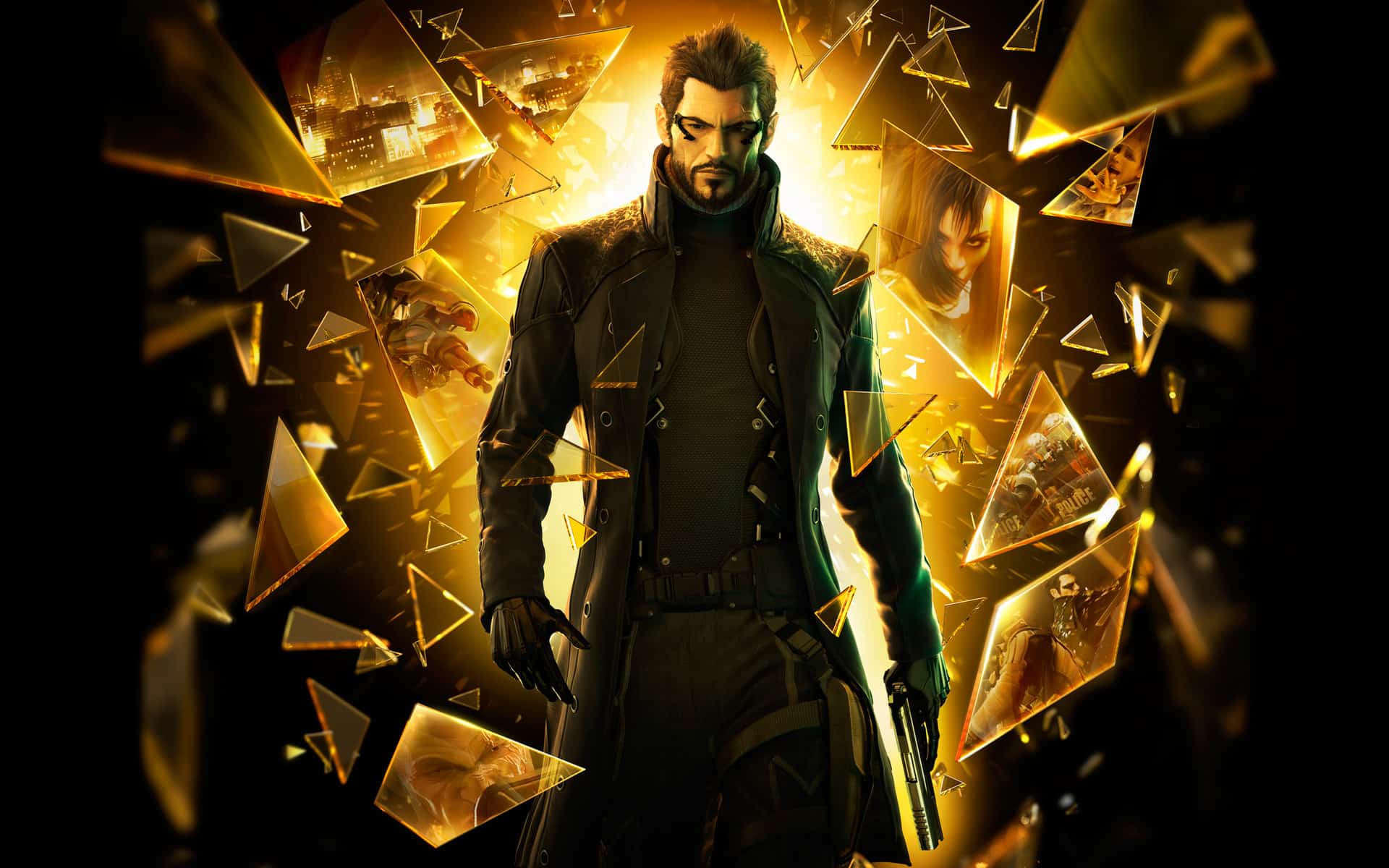You can trust VideoGamer. Our team of gaming experts spend hours testing and reviewing the latest games, to ensure you're reading the most comprehensive guide possible. Rest assured, all imagery and advice is unique and original. Check out how we test and review games here
My last preview for Deus Ex found me creeping around the twin hindrances of embargo restrictions and an innate desire to not spoil the game’s plot-heavy opening. In today’s write-up I’ll be describing a slightly different type of tippy-toeing, as I give my impressions of Adam Jensen’s proper mission – an assignment that sees him sneaking through a Sarif manufacturing plant that’s been seized by terrorists. I’ll do my best to avoid major spoilers, but be warned that I will be delving deeper into specific events this time around.
Jensen’s first true field assignment coincides with his first day back at work after the violent events that conclude the intro sequence. Before being deployed to the troubled facility in Detroit, I get a chance to explore the Sarif building he works in. As with the on-rails tour of the pre-credits sequence, the Sarif offices are a goldmine of subtle detail, but now I have the luxury of direct control. While the immediate goal is to get upstairs and receive a briefing from Frank Pritchard – the snarky technical wizard, who serves as your handler for the mission – there’s plenty of time and opportunity to nose around.
Everyone seems to have an opinion on Adam’s return and his new, mechanically-augmented appearance. I manage to sneak up on a colleague who’s fiercely questioning whether I’m still up for the job as Sarif’s head of security. This provides my first experience of the dialogue system, offering a choice between a soothing and explanatory response, or one in which I scathingly show him who’s boss. I opt for the latter, and my hapless critic receives a fiery tongue-lashing. “I am ADAM JENSEN, and I have mechanical arms, you big knob cheese!” Well okay, that’s not actually what Adam says. The dialogue is a tad more subtle than that, but his response still makes me feel like a badass.
I stumble across a couple of other neat finds at the Sarif building: a hidden note at the end of a lengthy air vent suggests some kind of optional side-quest – one that I don’t have time to investigate – while a trip to somewhere I’m not supposed to go results in an amusing nod-and-wink to the first Deus Ex. Before long, however, I’m in the back of a futuristic helicopter thing, en route to the beleaguered factory in Detroit.
My initial attempts at heroism don’t go too well. My prior experiences with the game have taught me to proceed with caution, but for a while this trepidation results in me crawling around corners like a terrified wimp. Then I accidentally end up wasting one of my most precious toys: for demo purposes, I’ve been allowed to pick a few of the high-end Augmentations that Adam will normally unlock later in the game (you slowly find the relevant mod-currency as the story progress, so at this point you’d usually be a barebones mecha-hero). Earlier I blew most of my upgrades on the super-sexy Claymore attack I first saw at E3 last year. Unfortunately, it’s only a matter of minutes before I then hit the trigger by mistake, pointlessly spuffing my steel balls all over a harmless wall. All of this happens before I’ve even reached the first of the naughty terrorists, I should add.
Thankfully, things pick up as soon as I’m confronted with a genuine threat. The outer area of the Detroit facility consists of a sizeable courtyard, watched over by a smattering of guards. Careful exploration uncovers a spread of paths through to the inner buildings. You can try to take the guards down one by one (a risky tactic, even with Adam’s skills), time your way past them, or find a course that bypasses them altogether. The options are familiar, but they’re presented in a way that feels pleasingly organic. The level design even manages to do the old “shift the crates about to open up a new route” dance without seeming forced, or even clichéd. I eventually find a way into the main building via the roof, following a tipoff from Pritchard over the comms.
Inside the building, it’s distinctly trickier to make clean progress. I’m only playing on the normal difficulty, but even so the guards can bring me down with just a few shots if they catch sight of me. Adam has his own weapons, too. Creeping up to a back-turned foe allows for a flashy takedown manoeuvre. These attacks drain the energy supply that fuels Adam’s augmentations, but they’ve very useful. You can opt for a lethal or non-lethal approach, but either way the result is the same: the perspective shifts from a first-person to a third-person view, and Adam eliminates his victim with style – knocking them out with brutal efficiency, or skewering them with the blades that slide out of his arms.
For more direct engagements, there’s always the option of more traditional weapons. At the outset of the mission you’re quizzed about whether you’re planning to kill or incapacitate the hostiles, and whether you want to tackle them at a distance or up close. Depending on your answers, you’ll be given a primary weapon to use on the job – though obviously there’s plenty of opportunity to grab more stuff as you go along. I end up mainly using a short-range taser – a weapon that’s far more useful than it sounds.
It takes me a while to settle into the rhythm of the action – which is to say I screw up and get killed a lot – but the failures never feel cheap or unfair. The guards seem blessed with fairly decent AI, reacting quickly to things they see and hear, and displaying a surprising degree of sense on the occasions when they spot me – acting upon my last known location, and refusing to blindly walk into deathtraps. There’s a refreshing lack of conveniently turned backs, too, and when I do make it through an area unscathed, it feels like I’ve genuinely outsmarted the opposition.
It’s not long before more complicated elements are thrown into the mix: gun turrets and security cameras, a hacking mini-game, and the need for strategic body dragging. Again, most of these elements feel familiar, but they’re implemented slickly and with confidence. There are always multiple options available in a given situation, and the individual mechanics work well together. At no point do I feel that the game explicitly wants me to take Approach A or Method B, and even comparatively risky strategies – like initiating direct combat or running flat-out through guarded areas – can work well if you time them properly. The stealth mechanics feel reassuringly tight and the jumps in camera perspective cease to be jarring as they become more commonplace.
The whole mission is beautifully paced, too. Death and disaster arrive at the drop of a hat, and while these slip-ups simply send you back to your last save or checkpoint, the whole experience is remarkably tense. While the primary aim of the mission is to retrieve something important from the Sarif labs, there’s also the option to rescue the poor buggers who’ve been held hostage. At the outset you don’t really know who the terrorists are or what they hope to achieve, and on top of that there’s a SWAT team eagerly waiting for their chance to swarm in and shoot everyone. There’s also another rather serious problem that threatens to ruin Adam’s day, but I’m not going to say what it is, because it’s a fun surprise that made me say a bad word when I stumbled across it. Let’s just say that things won’t go well if you take too long.
As the mission progresses the intensity of the situation is ramped up, helped in no small part by the conversations you overhear while creeping about. Obviously there’s not a lot of opportunity to sit down for a chat with Frank Terrorist and Chums, but there’s actually a surprisingly large volume of plot to digest, dished out via eavesdropping sessions and optional in-game media: newspapers, TV feeds and hacked email accounts. It’s all very much in the spirit of the original Deus Ex, and the exposition is generally handled with tact and intelligence.
I’m also happy to report that the voice acting appears to be of a very high standard. Indeed, it’s notable that the mission ultimately wraps up not with a frenzied shoot-out, but with you attempting to talk someone into releasing their human shield. As with the colleague intimidation conversation I mentioned earlier, you’re given a variety of possible approaches at each fork in the chatter: you might empathise with the hostage-taker, threaten them, or attempt to reason with them. Each choice gives you a rough idea of what Jensen is going to say, but there’s still an element of unpredictability with regards to what he’ll actually say. It’s not a million miles away from Mass Effect, in other words. There’s a genuine sense of parry and thrust to the negotiations, and unlike most RPG dialogue trees, the “correct” path is far from obvious.
I’m not sure if it’s smart play or simply blind luck, but my encounter with the gunman ends in success. He releases the hostage before slinking off into the shadows, and the mission draws to a close. I won’t lie: there’s quite a bit of swagger in my steps as I strut back to the helicopter – or at least, there is in my head. The game is still in first-person at that point, but I bet Jensen’s wiggling his mechanical ass in triumph.
“You made a lot of people very happy tonight, Jensen” beams the pilot. Come release day, we may be saying the same for Eidos Montreal.
Deus Ex: Human Revolution is due for release on PC, Xbox 360 and PS3 at some point after April 2011.
Deus Ex: Human Revolution
- Platform(s): macOS, PC, PlayStation 3, Xbox 360, Xbox One
- Genre(s): Action, First Person, RPG, Shooter

/https://oimg.videogamer.com/images/3242/deus_ex_3_19.jpg)






